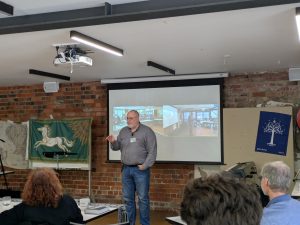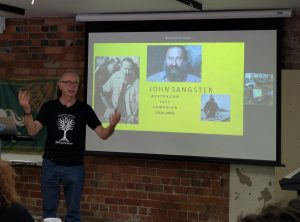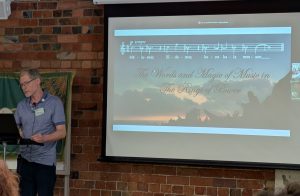Welcome
- In the grey area between fan convention and academic conference
Cover Versions: Exploring Adaptation Through Concepts of Legendarium Resonance by Louise Mathieson
- Which cover of the song “Over the Rainbow” do you like?
- People tend toward the original being best
- For Tolkien people have trouble even agreeing what is “canon”
- People criticise adaptations and what they change
- Borrow from music and “the cover version”
- Echos, resonance, harmony
- Repetition without replication
- Make the text or song ones own
- A cover version of a new interpretation of an existing musical work
- Difference between a cover version and a performance
- Is a performance always trying to be identical?
- Hetrocoosm – an adaption of an entire story world rather than a single story
- The Hobbit Trilogy
- Takes a children’s song and reconstructs as a complicated 3-part symphony
- Reconstruction of rhythmic elements and driven by temporal elements
- Harmonic and Dramatic deployment of consonance and dissonance
- The Language of a Cover Version is useful for examining Tolkien Adaptations
John Sangster: Australian Jazz Composer and Lord of the Rings by Andrew Johnson
- Born in Melbourne . 1928-1995
- Recorded 4 double albums about Middle Earth between 1974-78
- Overview of Career
- Traveled to Europe, learned the drums on the way over on the boat
- Learnt a lot over there and in US
- Came back to Australia. Was on TV regularly in various roles. Did music for various shows (eg Hanna Barbarra)
- Musical director of ‘Hair” musical in Australia
- Very busy with TV during day, gigs in evenings
- Tolkien
- Introduced in 1958
- Thought there should be more musical and adaptations of the stories
- The Hobbit Suite – 1973
- Sold well and had residuals from cartoon music. Gave him some time
- Released “Lord of the Rings” in 1974. Very successful . Jazz
- Created 16 more tracks and released as Volume 2 in 1975
- Volume 3 in 1976
- Lots of amusing songs titles
- Two additional Albums with music
- Music reissued following Jackson LOTR movies
- Total seven hours of music
- No issues with Tolkien Estate at the time
- The album covers
- Tracks for albums are listed here and nearby pages
Presentation: Phillip Menzies – The Words and Magic of Music in Rings of Power
- Explanation of various bits of music in the Rings of Power
- Themes from locations like Valinor
- Themes for People like Galadriel ( one of the most common on the show)
- Galadriel also has a second theme that hasn’t been heard in the show yet
- Sauron’s theme. Ostinato
- See the S1 Prologue scene (with young Galadriel’s boat) has some of Sauron’s theme
- The Boy with Red Head might be a Sauron equivalent (or even him)
- Red Hair in the series is often linked to evil
- Had to skip the music in the Anatar revel in S2 due to time
- What does Magic sound like?
- Examples
- The Stranger
- Lots of hooks in with the Magic music. Like the magic is part of him











